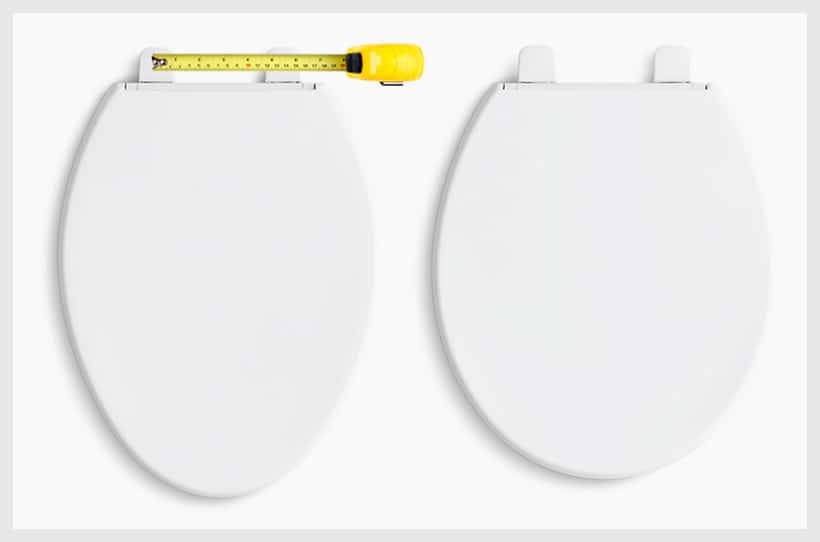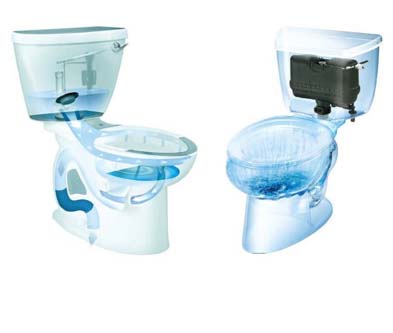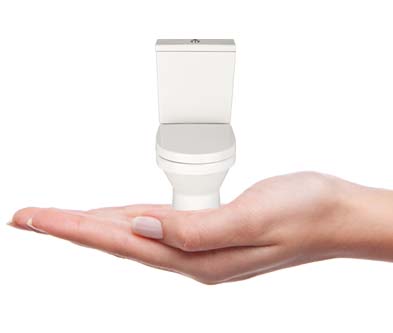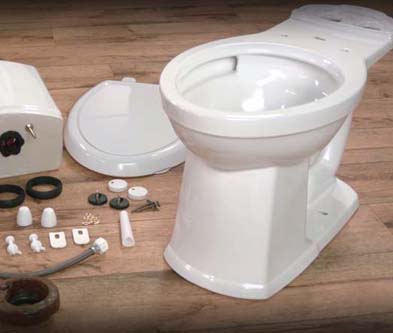Toilet Found! is sustained by readers who made purchases through specific links on this site. Learn more
How to Measure a Toilet Seat to Match the Bowl Perfectly

Toilet Seat Measuring Guide for The Perfectionists
Why would anyone waste their time learning how to measure a toilet seat? Aren’t toilet manufacturers supposed to provide the seat, be it free or bought separately, that fits perfectly the toilet bowl of whatever toilet model they supplied?
Those are fair questions there. But what if you need to replace your existing toilet seat and discover that the toilet model has been discontinued? And the new model seat doesn’t quite fit your toilet bowl. You will be forced to buy a 3rd party seat if you don’t want to upgrade to the latest toilet model.
Or you want a bidet seat, and the toilet maker does not produce one. It’s not unusual. Even TOTO, the leader in bidet seats and smart toilets, can’t promise its washlets can fit all of its toilet models.
Whatever. It certainly doesn’t hurt to gain a little knowledge here.
But first, let’s go mainstream and get all the measurements the old-school way. So go grab a piece of paper, a pencil, and a tape measure.
Get The Shape Right
Before you begin to measure the bowl, have a look at the bowl shape. The majority of toilet bowls in the United States will look like these:

If yours look nothing close to those types of toilet bowls above, please buy back the original seat. And if the maker has stopped producing the model that you own, consider replacing the whole toilet. That’s the risk and disadvantage of having an odd-shaped bowl.
Finding a matching seat for the D-shape and square bowl is easy because they have straight sides, unlike the round and elongated bowls. So if you are buying a 3rd party round or elongated toilet seat, be prepared to accept a little discrepancy on the curve part even if they are of standard size seat.
But what’s more important is stability. Once installed, ensure the seat is not going anywhere, like wobbling or shifting.
Standard Sizes Seat – According to Whose Standard?
The general consensus is that a round bowl will have a length of 16-1/2 inches measured from the bolt holes to the bowl tip, and the elongated bowl is about 2 inches longer at 18-1/2 inches. That’s true when you have a standard or common round or elongated shape bowl of a popular brand/model.
But the reality is some D-shape bowls are categorized as standard elongated bowls by the manufacturer. And some elongated bowls are under 18 inches, especially those of compact-size toilets.
So by saying ‘standard size,’ you must be careful of what you will be getting without the specifics, especially when you have a toilet model or brand that is less popular. The best way out of this confusion is to get the shape and dimensions right.
3 Simple Steps to Get the Measurement
Follow these 3 simple steps, and you will return to watching your favorite cat videos within a minute.

Standard Measurement of Toilet Seats
This is the standard measurement applicable also to bidet seats.
Armed with these measurements, head to your local hardware store and choose a toilet seat that matches the measurements you took.
If you order the seat online, check the dimension on the manufacturer’s specification sheet. They have to match your measurement as much as possible. Especially for 3rd party seats, give and take 5 mm or a quarter-inch difference is fine.
However, some seat models have adjustable hinges and bolt distance. So be sure to look for those adjustable seats if the length dimension misses just a little to get the perfect fit.
Check the Seat Bumper
Once you have installed the seat, ensure the seat bumpers are firmly seated on the bowl rim. All the bumpers must be aligned to have full surface contact on the rim for stability.

An unstable seat will wobble or tip over when someone sits on it. This can result in an injury. So make sure the seat is fastened securely after all adjustments are made. Then give it a try, sit on it, wiggle a bit, or adjust your sitting position randomly to make sure nothing shifts.
Watch the Curves For Better Accuracy
Getting a perfectly matched 3rd party toilet seat can be difficult, especially if you have a round or elongated toilet of a less well-known brand. Just like smartphone covers, there is no lack of options if you own an Apple or Samsung phone. But good luck if you own an Asus or Oppo or any brand practically unheard of.
The problem is with the bowl’s curve edges. It would help if you observed the curve angle or the degree to which a curve deviates. They differ from manufacturer to manufacturer. So getting a more thorough measurement to include the curve angle is important if you want a perfect match.
However, you cannot verify the curve angle with all toilet seat spec sheets as they only show the standard measurement. But it is useful, and you can still confirm the angle on the spec sheet (you’ll learn in a second).
A more accurate measurement will be to measure from the widest part of the bowl to the bolt-hole center (A) and another to the front edge of the bowl (B), as shown in the image below. You will get a perfect fit if both A and B measurements match the seat dimensions.

But if you buy online, the curve angle will greatly help. As most seat catalogs or online images will show a top view of the seat, you can print out the image and use a protractor to measure the curve angles, as shown above. Or you can use a protractor app to get the curve angle on a mobile device.
Once you have verified the angle, tally it with the seat length (A + B) to confirm if the round or elongated seat matches your measurement. All makes of toilet seats will have the seat length indicated in the catalogs or specifications.
So, if you want the most accurate measurement, get these dimensions ready:
You may not get a perfect match on the curve angle or measurements of A and B. Then, that will depend on the degree of deviation. It is more critical on the angles, so try to keep the deviation to less than half a degree, more or less. And no more than 3mm on A and B, as the differences will be doubled on the overall length of the seat.
Measurements For a Bidet Seat
The same measurements discussed above can be applied to bidet seats. But if you observe the shape of a bidet seat, in general, almost all of them look like this:

They are meant for elongated toilets, all with straight sides. The round bidet seats will have the same straight sides – D-shaped. This design for bidet seats is logical, given that a wider space is necessary at the rear to accommodate the bidet components, like the water pump and nozzle mechanism. A tapered back will pose some challenges to housing all the components.
So, suppose you plan to get an elongated toilet. In that case, you may consider having one that matches more with the *bidet seats, so you can easily find a matching one later when you decide to upgrade.

*For bidet seats, please follow the manufacturer’s guide. Most will require a spacing of at least 2 inches between the front of the tank and the bolt holes. And if you have a one-piece toilet with a french curve between the tank and the bowl, the seat will not fit properly and will cause damage to the seat.
Quick and Most Accurate Method, But You Have to be Brave
The fastest and most accurate way to determine a matching seat is to remove the seat from your toilet and bring it to the store. If you don’t think you could bring yourself to do that, here’s a better way.
Don’t worry about all the embarrassment concerns. Hardly an hour after you leave the store, nobody remembers you.

Summary
Attention to detail is the key to getting a toilet seat that matches the bowl perfectly. The more measurements you can obtain, the better. But those details must be verifiable, especially when you are buying online.
Though there are a ton of 3rd party seats available, you still may not get one that matches perfectly. There will be a few under or overhangs at some places, but that’s a good match as long as it is stable and visually acceptable. Otherwise, the original seat is the only thing that is made for your toilet.
Last but not least, there’s nothing wrong with bringing the whole seat to the store. Just make sure you thoroughly clean it and present it hygienically. Shrink wrap or vacuum pack it if possible. You don’t have to unwrap it when comparing seats for a match at the store.








